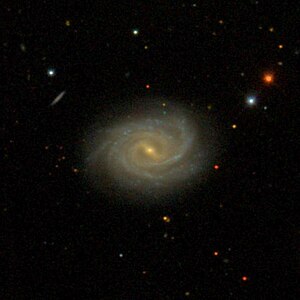NGC 4210
| Galaxie NGC 4210 | |
|---|---|
 | |
| SDSS-Aufnahme | |
| AladinLite | |
| Sternbild | Drache |
| Position Äquinoktium: J2000.0, Epoche: J2000.0 | |
| Rektaszension | 12h 15m 15,8s[1] |
| Deklination | +65° 59′ 07″ [1] |
| Erscheinungsbild | |
| Morphologischer Typ | SB(r)b / LINER [1][2] |
| Helligkeit (visuell) | 12,5 mag [2] |
| Helligkeit (B-Band) | 13,3 mag [2] |
| Winkelausdehnung | 2′ × 1,6′ [2] |
| Positionswinkel | 105° [2] |
| Flächenhelligkeit | 13.6 mag/arcmin² [2] |
| Physikalische Daten | |
| Zugehörigkeit | NGC 4256-Gruppe LGG 277 [1][3] |
| Rotverschiebung | 0.009113 ± 0.000023 [1] |
| Radialgeschwindigkeit | 2732 ± 7 km/s [1] |
| Hubbledistanz vrad / H0 | (127 ± 9) · 106 Lj (39,0 ± 2,7) Mpc [1] |
| Geschichte | |
| Entdeckung | William Herschel |
| Entdeckungsdatum | 20. März 1790 |
| Katalogbezeichnungen | |
| NGC 4210 • UGC 7264 • PGC 39184 • CGCG 315-028 • MCG +11-15-039 • IRAS 12128+6615 • 2MASX J12151588+6559075 • GC 2801 • H III 850 • h 1143 • NVSS J121515+655856 • LDCE 889 NED004 | |
NGC 4210 ist eine Balken-Spiralgalaxie mit aktivem Galaxienkern vom Hubble-Typ SBb im Sternbild Drache am Nordsternhimmel. Sie ist schätzungsweise 127 Millionen Lichtjahre von der Milchstraße entfernt und hat einen Durchmesser von etwa 75.000 Lj.
Im selben Himmelsareal befinden sich u. a. die Galaxien NGC 4221 und NGC 4256.
Die Typ-Ic-Supernova SN 2002ho wurde hier beobachtet.[4]
Gemeinsam mit NGC 4108, NGC 4221, NGC 4332, NGC 4256, NGC 4513 und PGC 38461 bildet sie die NGC 4256-Gruppe.[3]
Das Objekt wurde am 20. März 1790 vom deutsch-britischen Astronomen Wilhelm Herschel entdeckt.[5]
Weblinks
Einzelnachweise
Auf dieser Seite verwendete Medien
Autor/Urheber: Sloan Digital Sky Survey, Lizenz: CC BY 4.0
The sky image is obtained by Sloan Digital Sky Survey, DR14 with SciServer.
Angle of view: 4' × 4' (0.3" per pixel), north is up.
Details on the image processing pipeline: https://www.sdss.org/dr14/imaging/jpg-images-on-skyserver/



